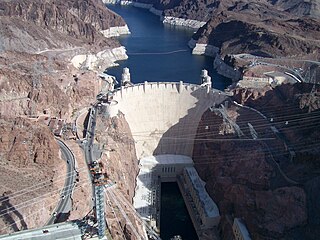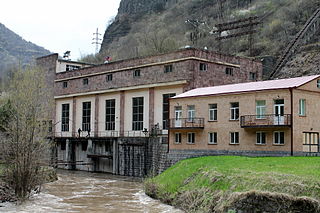
The Itaipu Dam is a hydroelectric dam on the Paraná River located on the border between Brazil and Paraguay. It is the third largest hydroelectric dam in the world, and holds the 45th largest reservoir in the world.

The economy of South America comprises approximately 434 million people living in twelve nations and three territories. It encompasses 6 percent of the world's population.

Eletrobras is a major Brazilian electric utilities company. The company's headquarters are located in Rio de Janeiro.

Andrade Gutierrez is a Brazilian private multinational conglomerate headquartered in Belo Horizonte. The company was founded in 1948, in Belo Horizonte, Minas Gerais by the Andrade and Gutierrez families. As of 2013, Andrade Gutierrez is the second largest construction company in Brazil with branches in 44 countries and a net income of 8 billion BRL.

CPFL Energia (former name: Companhia Paulista de Força e Luz) is the second largest non state-owned group of electric energy generation and distribution in Brazil and the third biggest Brazilian electric utility company, after Eletrobras and Energisa. The corporation is composed by CPFL Brasil, CPFL Piratininga, CPFL Paulista, CPFL Geração, CPFL Renováveis, Rio Grande Energia (RGE) and SEMESA. Each of these companies operates as a holding company that owns dozens of other companies. Its headquarters are located in Campinas, the third-largest city in state of São Paulo. In 2017, it was purchased by the Chinese utility State Grid Corporation of China, a state-owned enterprise under State-owned Assets Supervision and Administration Commission of the State Council.

Brazilian industry has its earliest origin in workshops dating from the beginning of the 19th century. Most of the country's industrial establishments appeared in the Brazilian southeast, and, according to the Commerce, Agriculture, Factories and Navigation Joint, 77 establishments registered between 1808 and 1840 were classified as "factories" or "manufacturers". However, most, about 56 establishments, would be considered workshops by today's standards, directed toward the production of soap and tallow candles, snuff, spinning and weaving, foods, melting of iron and metals, wool and silk, amongst others. They used both slaves and free laborers.

Brazil is the 10th largest energy consumer in the world and the largest in South America. At the same time, it is an important oil and gas producer in the region and the world's second largest ethanol fuel producer. The government agencies responsible for energy policy are the Ministry of Mines and Energy (MME), the National Council for Energy Policy (CNPE), the National Agency of Petroleum, Natural Gas and Biofuels (ANP) and the National Agency of Electricity (ANEEL). State-owned companies Petrobras and Eletrobras are the major players in Brazil's energy sector, as well as Latin America's.
The electricity sector in Argentina constitutes the third largest power market in Latin America. It relies mostly on thermal generation and hydropower generation (36%). The prevailing natural gas-fired thermal generation is at risk due to the uncertainty about future gas supply.
Brazil has the largest electricity sector in Latin America. Its capacity at the end of 2021 was 181,532 MW. The installed capacity grew from 11,000 MW in 1970 with an average yearly growth of 5.8% per year. Brazil has the largest capacity for water storage in the world, being dependent on hydroelectricity generation capacity, which meets over 60% of its electricity demand. The national grid runs at 60 Hz and is powered 83% from renewable sources. This dependence on hydropower makes Brazil vulnerable to power supply shortages in drought years, as was demonstrated by the 2001–2002 energy crisis.

Hydroelectricity is, as of 2019, the second-largest renewable source of energy in both generation and nominal capacity in the United States. In 2021, hydroelectric power produced 31.5% of the total renewable electricity, and 6.3% of the total U.S. electricity.
Energy in Serbia describes energy and electricity production, consumption and import in Serbia.

PJSC «Ukrhydroenergo» is a Ukrainian state-owned enterprise that administers many major hydro power plants along the Dnieper and Dniester rivers. It is Ukraine's main hydropower generating company. It is capable of covering peak loads and providing FCAS for the United Energy Systems of Ukraine (UESU). Hydroelectricity is a renewable energy source, and does not require the combustion of fossil fuels in its operation. The company operates ten power plants on the Dnieper and Dniester rivers: Kyivska HPP, Kyivska PSP, Kanivska HPP, Kremenchutska HPP, Seredniodniprovska HPP, Dniprovska HPP No. 1, Dniprovska HPP No. 2, Kakhovska HPP, Dnistrovska HPP, and Dnistrovska PSP. Enabling works are underway at Kanivska PSP and Kakhovska HPP No. 2.

The electricity sector of Kosovo relies on coal-fired power plants and is considered one of the sectors with the greatest potential of development. The inherited issues after the war in Kosovo and the transition period have had an immense effect on the progress of this sector.

Renewable energy in Costa Rica supplied about 98.1% of the electrical energy output for the entire nation in 2016. Fossil fuel energy consumption in Costa Rica was 49.48 as of 2014, with demand for oil increasing in recent years. In 2014, 99% of its electrical energy was derived from renewable energy sources, about 80% of which from hydroelectric power. For the first 75 days of 2015, 100% of its electrical energy was derived from renewable energy sources and in mid 2016 that feat was accomplished for 110 consecutive days despite suboptimal weather conditions.

The Dzoraget Hydroelectric Power Station is situated in Dzoraget village, Lori Region, Armenia. The plant is located on the coast of Debed River, but it uses the flows of the waters of Dzoraget River. Construction of the Dzoraget HPP started in 1927 and it was launched on 15 November 1932 with the full installed capacity of 22.32 MW. As of 1980, the plant uses three generators with an installed capacity of 26.2 MW. The Dzoraget Hydro Power Plant is considered to be small size power plant. There is a little water storage behind the weir, as Dzoraget HPP is a run-of-the-river plant.

Linx S.A. is a Brazilian management software company and the largest software house in retail management systems in Latin America. According to the American technology consulting firm IDC, Linx retains 40.2% of the retail management software in Brazil. In 2007, Linx was listed for the 3rd time in the Valor 1000 annual report, which lists the 1000 biggest Brazilian companies. In August 2020, payment processor StoneCo merged with Linx's operations in a deal worth $1.1 billion.

The Tucuruí transmission line is a hydroelectric power line that leads north from the Tucuruí Dam in Pará, Brazil and crosses the Amazon River. From there the eastern branch leads to Macapá in Amapá and the western branch leads to Manaus in Amazonas. The towers supporting the span across the Amazon River are nearly as high as the Eiffel Tower. Work to extend the line from Manaus north to Boa Vista, Roraima, is due to complete in 2018. There were delays in issuing the environmental permits and then legal challenges since the line crosses the territory of indigenous people who had not been consulted. Although efforts have been made to avoid environmental damage, there has been controversy about the impact of construction and of the tower maintenance corridor.
The Cachoeira do Cai Dam is a planned hydroelectric dam on the Jamanxim River in the state of Pará, Brazil, with a capacity of 802 megawatts (1,075,000 hp).
The Cachoeira dos Patos Dam is a proposed hydroelectric dam on the Jamanxim River in the state of Pará, Brazil. Work has been delayed due to concern about environmental impact and lack of consultation with affected indigenous people.

The power generation potential of the rivers in Azerbaijan is estimated at 40 billion kilowatt per hour, and feasible potential is 16 billion kilowatt per hour. Small-scale hydro has significant developmental potential in Azerbaijan. In particular, the lower reaches of the Kura river, the Aras river and other rivers flowing into the Caspian Sea. Hydropower could conceivably provide up to 30% of Azerbaijan’s electricity requirements. Currently, hydropower, dominated by large-scale dams, provides 11.4% of Azerbaijan’s electricity.















